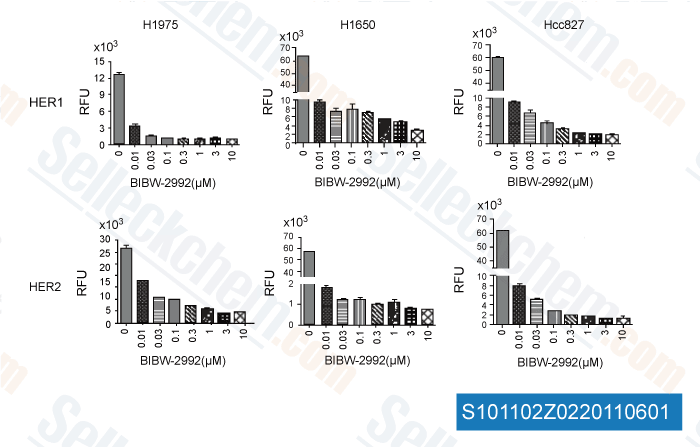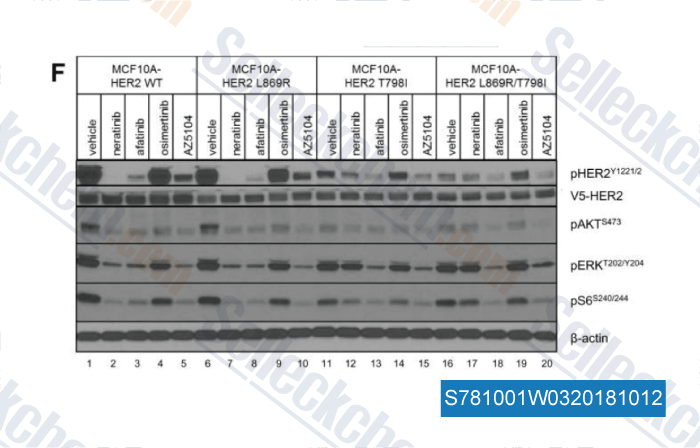|
Toll Free: (877) 796-6397 -- USA and Canada only -- |
Fax: +1-832-582-8590 Orders: +1-832-582-8158 |
Tech Support: +1-832-582-8158 Ext:3 Please provide your Order Number in the email. |
Technical Data
| Formula | C24H25ClFN5O3.2C4H4O4 |
|||
| Molecular Weight | 717.18 | CAS No. | 850140-73-7 | |
| Solubility (25°C)* | In vitro | DMSO | 100 mg/mL (139.43 mM) | |
| Water | 50 mg/mL (69.71 mM) | |||
| Ethanol | Insoluble | |||
|
* <1 mg/ml means slightly soluble or insoluble. * Please note that Selleck tests the solubility of all compounds in-house, and the actual solubility may differ slightly from published values. This is normal and is due to slight batch-to-batch variations. * Room temperature shipping (Stability testing shows this product can be shipped without any cooling measures.) |
||||
Preparing Stock Solutions
Biological Activity
| Description | Afatinib Dimaleate irreversibly inhibits EGFR/HER2 including EGFR(wt), EGFR(L858R), EGFR(L858R/T790M) and HER2 with IC50 of 0.5 nM, 0.4 nM, 10 nM and 14 nM, respectively; 100-fold more active against Gefitinib-resistant L858R-T790M EGFR mutant. Afatinib (BIBW2992) Dimaleate induces autophagy. | ||||||||
|---|---|---|---|---|---|---|---|---|---|
| Targets |
|
||||||||
| In vitro | BIBW2992 is more effective than erlotinib, gefitinib, or lapatinib in inhibiting survival of lung cancer cell lines harboring wild-type (H1666) or L858R/T790M (NCI-H1975) EGFR. BIBW2992 is similarly effective against NSCLC lines expressing HER2 776insV (NCI-H1781) or EGFR E746_A750del (HCC827), but shows no activity toward A549 cells, which express wild-type EGFR and HER2.[1] Afatinib enhances cytotoxicity of topotecan and mitoxantrone to SP cells, and increases the apoptosis induced by topotecan and mitoxantrone in SP cells.[2] | ||||||||
| In vivo | In the MDA-MB-453 xenograft model, BIBW2992 (20 mg/kg, p.o.) results in dramatic tumor regression with a cumulative treated/control tumor volume ratio (T/C ratio) of 2%, and downregulation of EGFR and AKT phosphorylation.[1] In A7, A431, FaDu, UT-SCC-14 and UT-SCC-15 xenograft models, application of BIBW 2992 (30 mg/kg, p.o.) leads to a significant prolongation of tumour growth time.[3] In HER2-amplified xenograft medel, Afatinib (30 mg/kg, p.o.) results a markedly inhibition in tumor growth and a significant improvement in the duration of overall survival.[4] In HER2-positive gastric cancer NCI-N87 xenograft, afatinib (25 mg/kg, p.o.) leads to dramatic tumor volume regression within 4 d and near-complete tumor resolution after 21 d of treatment.[5] |
Protocol (from reference)
| Kinase Assay:[1] |
|
|---|---|
| Cell Assay:[2] |
|
| Animal Study:[4] |
|
References
Customer Product Validation

-
Data from [Data independently produced by Int J Proteomics, 2011, 215496]

-
Data from [Data independently produced by Int J Proteomics, 2011, 215496]

-
Data from [Data independently produced by , , Cancer Discov, 2017, 7(6):575-585]

-
Data from [Data independently produced by , , J Thorac Oncol, 2017, 12(5):884-889]
Selleck's Afatinib Dimaleate has been cited by 169 publications
| Romidepsin and afatinib abrogate JAK-STAT signaling and elicit synergistic antitumor effects in cutaneous T-cell lymphoma [ J Invest Dermatol, 2024, S0022-202X(23)03210-4] | PubMed: 38219917 |
| Discovery of nontriterpenoids from the rot roots of Panax notoginseng with cytotoxicity and their molecular docking study and experimental validation [ RSC Adv, 2023, 13(16):11037-11043] | PubMed: 37033442 |
| Irreversible tyrosine kinase inhibitors induce the endocytosis and downregulation of ErbB2 [ Biochem Biophys Rep, 2023, 34:101436] | PubMed: 36824069 |
| Silent mutations reveal therapeutic vulnerability in RAS Q61 cancers [ Nature, 2022, 603(7900):335-342] | PubMed: 35236983 |
| Group 3 innate lymphoid cells produce the growth factor HB-EGF to protect the intestine from TNF-mediated inflammation [ Nat Immunol, 2022, 23(2):251-261] | PubMed: 35102343 |
| PI3Kγ stimulates a high molecular weight form of myosin light chain kinase to promote myeloid cell adhesion and tumor inflammation [ Nat Commun, 2022, 13(1):1714] | PubMed: 35361816 |
| Pyruvate Facilitates FACT-Mediated γH2AX Loading to Chromatin and Promotes the Radiation Resistance of Glioblastoma [ Adv Sci (Weinh), 2022, 10.1002/advs.202104055] | PubMed: 35048565 |
| EGFR/MET promotes hepatocellular carcinoma metastasis by stabilizing tumor cells and resisting to RTKs inhibitors in circulating tumor microemboli [ Cell Death Dis, 2022, 13(4):351] | PubMed: 35428350 |
| Aurora kinase blockade drives de novo addiction of cervical squamous cell carcinoma to druggable EGFR signalling [ Oncogene, 2022, 10.1038/s41388-022-02256-3] | PubMed: 35250028 |
| HER3 activation contributes toward the emergence of ALK inhibitor-tolerant cells in ALK-rearranged lung cancer with mesenchymal features [ NPJ Precis Oncol, 2022, 6(1):5] | PubMed: 35042943 |
RETURN POLICY
Selleck Chemical’s Unconditional Return Policy ensures a smooth online shopping experience for our customers. If you are in any way unsatisfied with your purchase, you may return any item(s) within 7 days of receiving it. In the event of product quality issues, either protocol related or product related problems, you may return any item(s) within 365 days from the original purchase date. Please follow the instructions below when returning products.
SHIPPING AND STORAGE
Selleck products are transported at room temperature. If you receive the product at room temperature, please rest assured, the Selleck Quality Inspection Department has conducted experiments to verify that the normal temperature placement of one month will not affect the biological activity of powder products. After collecting, please store the product according to the requirements described in the datasheet. Most Selleck products are stable under the recommended conditions.
NOT FOR HUMAN, VETERINARY DIAGNOSTIC OR THERAPEUTIC USE.
